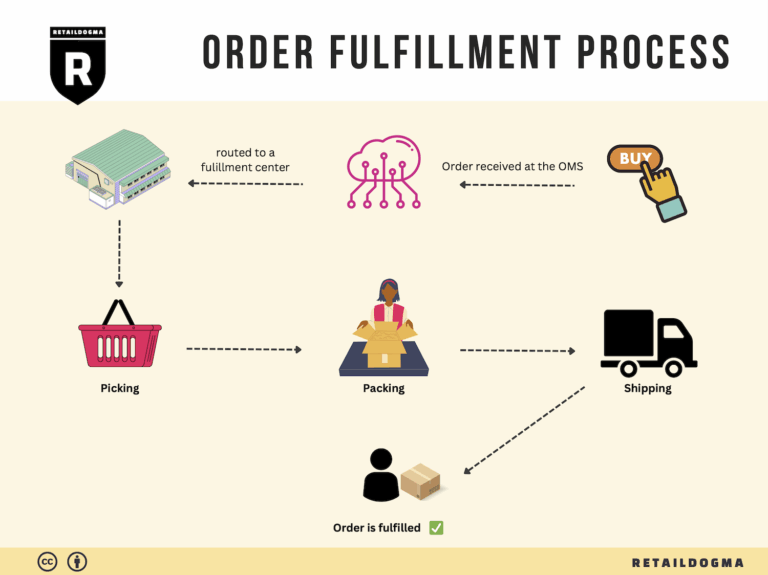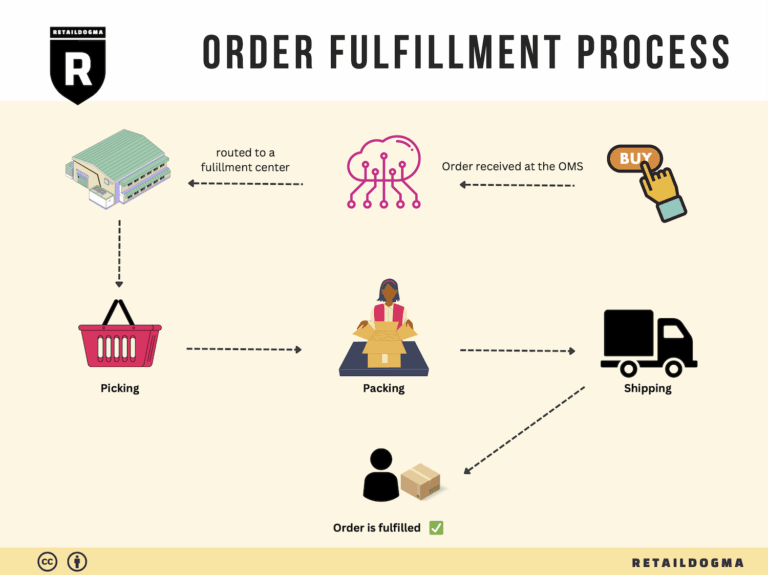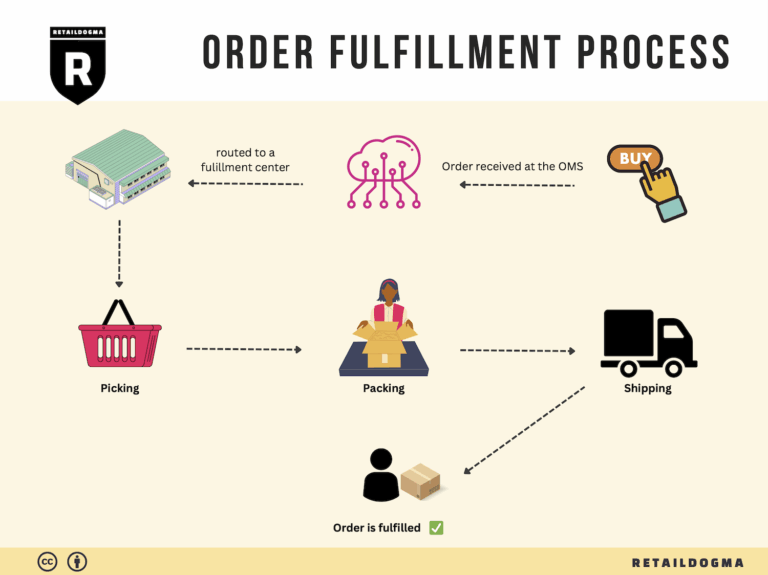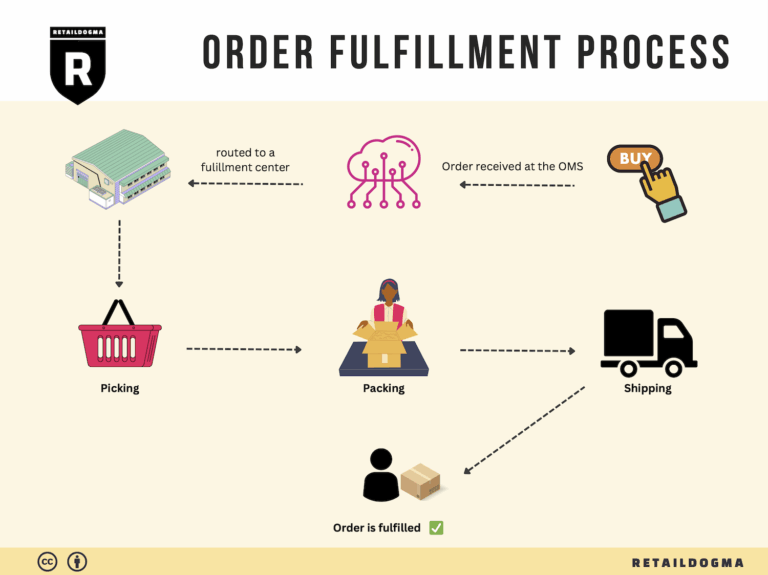How Order Fulfillment Works: A Step-by-Step Guide for Businesses
What is E-commerce Fulfillment? An Introduction for Growing Businesses
As an e-commerce business owner, you may find yourself grappling with a significant challenge: managing the overwhelming demands of packing and shipping orders. This aspect of your operations can quickly become a bottleneck, consuming your time and resources, and ultimately hindering your ability to scale. Fulfillment, in its simplest terms, refers to the entire process of getting a product from your inventory to your customer’s doorstep. It encompasses everything from order processing and inventory management to packing and shipping.
Understanding e-commerce fulfillment is crucial for any growing business. This guide aims to demystify the various fulfillment models available, including third-party logistics (3PL) and Fulfillment by Amazon (FBA). We will delve into the core services offered by fulfillment partners, such as inventory storage, order picking, packing, and shipping. Each model has its unique advantages and challenges, and understanding these can help you make informed choices that align with your business goals.
Additionally, we will discuss how to select the right fulfillment partner. Choosing a logistics provider is not merely about cost; it involves evaluating their capabilities, technology, customer service, and scalability. A solid partner can help streamline your operations, allowing you to focus on what you do best—growing your business.
Pricing is another critical aspect we’ll cover. Fulfillment costs can vary significantly based on the model you choose and the services you require. By breaking down the various pricing structures, we aim to equip you with the knowledge needed to budget effectively and avoid unexpected expenses.
Ultimately, the goal of this guide is to empower you to make smart, strategic decisions about your logistics operations. By understanding the ins and outs of e-commerce fulfillment, you can alleviate the stress of packing and shipping, enhance your customer experience, and position your business for sustainable growth. Whether you’re just starting or looking to optimize your existing processes, this guide will provide you with the insights necessary to navigate the complexities of fulfillment in the e-commerce landscape.
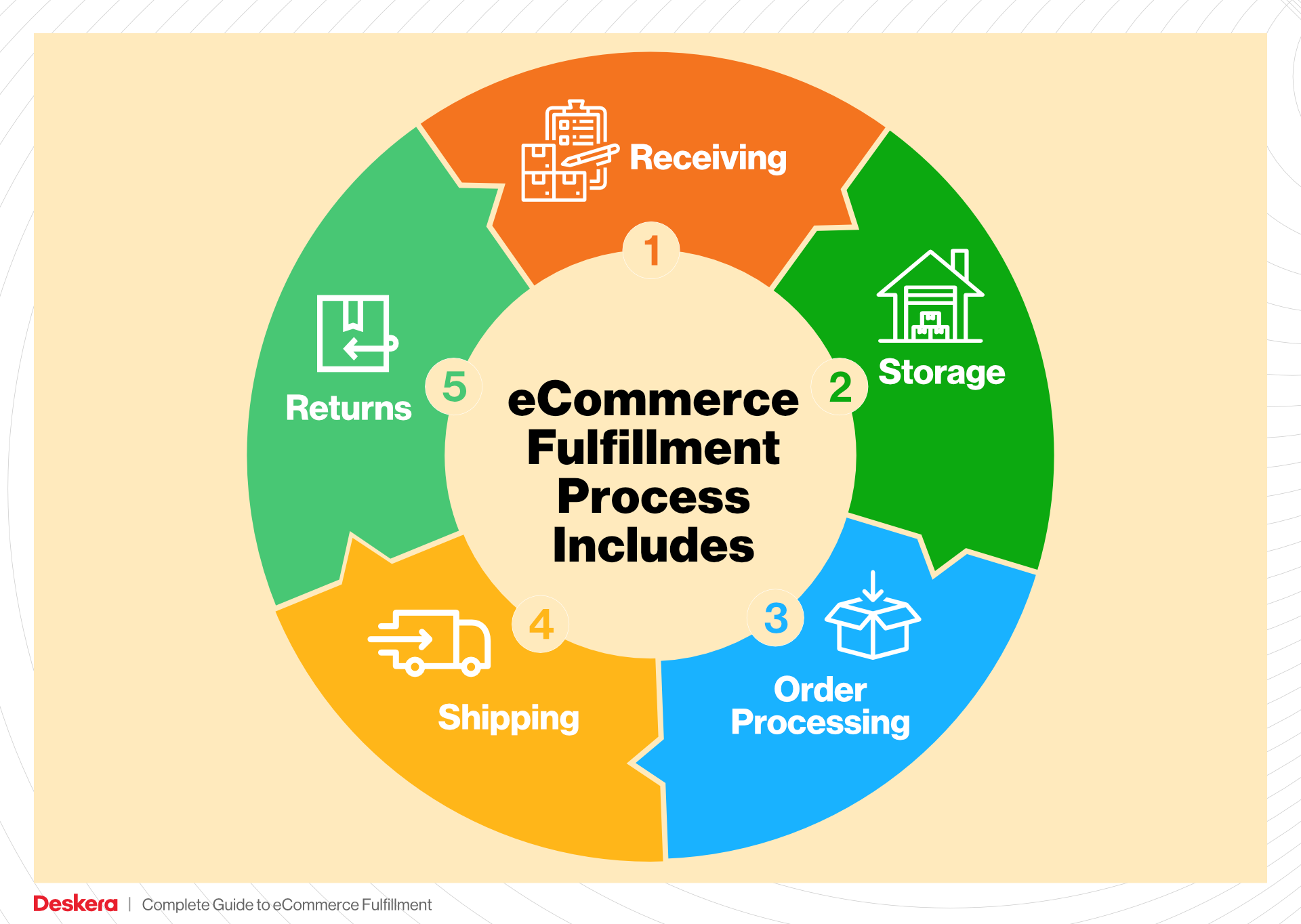
What You’ll Learn In This Guide
- What is E-commerce Fulfillment? An Introduction for Growing Businesses
- The Order Fulfillment Process: From ‘Buy’ Button to Customer’s Door
- Comparing Fulfillment Models: In-House vs. 3PL vs. Dropshipping
- A Deep Dive into Amazon FBA: Pros, Cons, and Who It’s For
- Core Services Offered by Fulfillment Centers
- How to Choose a Fulfillment Partner: A 6-Point Checklist
- Understanding Fulfillment Pricing: A Breakdown of Common Fees
- Frequently Asked Questions (FAQs) about Fulfillment
- Conclusion: Is Outsourcing Fulfillment the Right Move for Your Business?
- Important Disclaimer
The Order Fulfillment Process: From ‘Buy’ Button to Customer’s Door
1. Receiving Inventory
The first step in the order fulfillment process is receiving inventory. This involves the arrival of products at the fulfillment center from suppliers or manufacturers. Upon arrival, each shipment is checked against the purchase order to ensure the correct items and quantities have been received.
Importance: This step is crucial because it sets the foundation for accurate inventory management. Any discrepancies can lead to stockouts or overstock situations, impacting customer satisfaction and operational efficiency.
Key Term: SKU (Stock Keeping Unit). Each product is assigned a unique SKU, which helps in tracking inventory levels and streamlining the receiving process. Using SKUs allows for quick identification and minimizes errors when sorting and storing products.
2. Warehouse Storage
Once the inventory is received, the next step is warehouse storage. Products are organized in designated areas within the fulfillment center based on their SKU, size, and demand frequency. High-demand items are typically placed in easily accessible locations to facilitate quick retrieval.
Importance: Efficient warehouse storage maximizes space utilization and minimizes the time required to pick orders. A well-organized warehouse reduces the likelihood of misplacing items, which can lead to delays in order fulfillment.
Key Term: ABC Analysis. This inventory categorization technique helps prioritize items based on their sales volume and value. ‘A’ items are high-value and low-quantity, ‘B’ items are moderate in both value and quantity, and ‘C’ items are low-value and high-quantity. This classification helps in optimizing storage solutions.
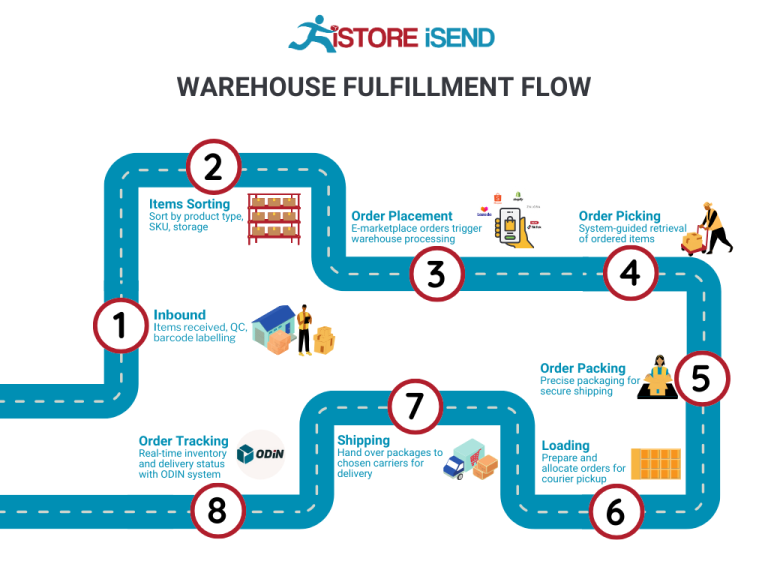
3. Order Picking
The order picking step involves selecting the appropriate items from the warehouse to fulfill customer orders. Warehouse staff use tools such as pick lists, which detail the SKUs and quantities needed for each order. They may employ various picking methods, such as single order picking or batch picking, depending on the order volume.
Importance: Effective order picking is critical for meeting customer expectations regarding speed and accuracy. A delay or error in picking can lead to customer dissatisfaction and increased returns.
Key Term: Pick Lists. These documents guide warehouse staff in locating and retrieving the correct items efficiently. A well-structured pick list not only streamlines the picking process but also minimizes the risk of errors, ensuring that customers receive exactly what they ordered.
4. Order Packing
After items are picked, they move to the packing station. During this step, items are carefully packed into boxes or envelopes, often with protective materials to prevent damage during transit. Packing slips are typically included, providing customers with details about their orders.
Importance: Proper packing is essential for protecting products and ensuring they arrive in good condition. Additionally, effective packing can reduce shipping costs by optimizing package size and weight.
Key Term: Packing Slip. This document outlines the contents of the package and serves as a receipt for the customer. It is also a vital tool for inventory management, helping to verify that the correct items have been packed.
5. Shipping & Delivery
The final step in the order fulfillment process is shipping and delivery. Once packed, orders are labeled and dispatched to the appropriate shipping carriers. Businesses must choose the right shipping methods based on cost, speed, and customer preferences. Tracking information is often provided to customers to keep them informed about their order status.
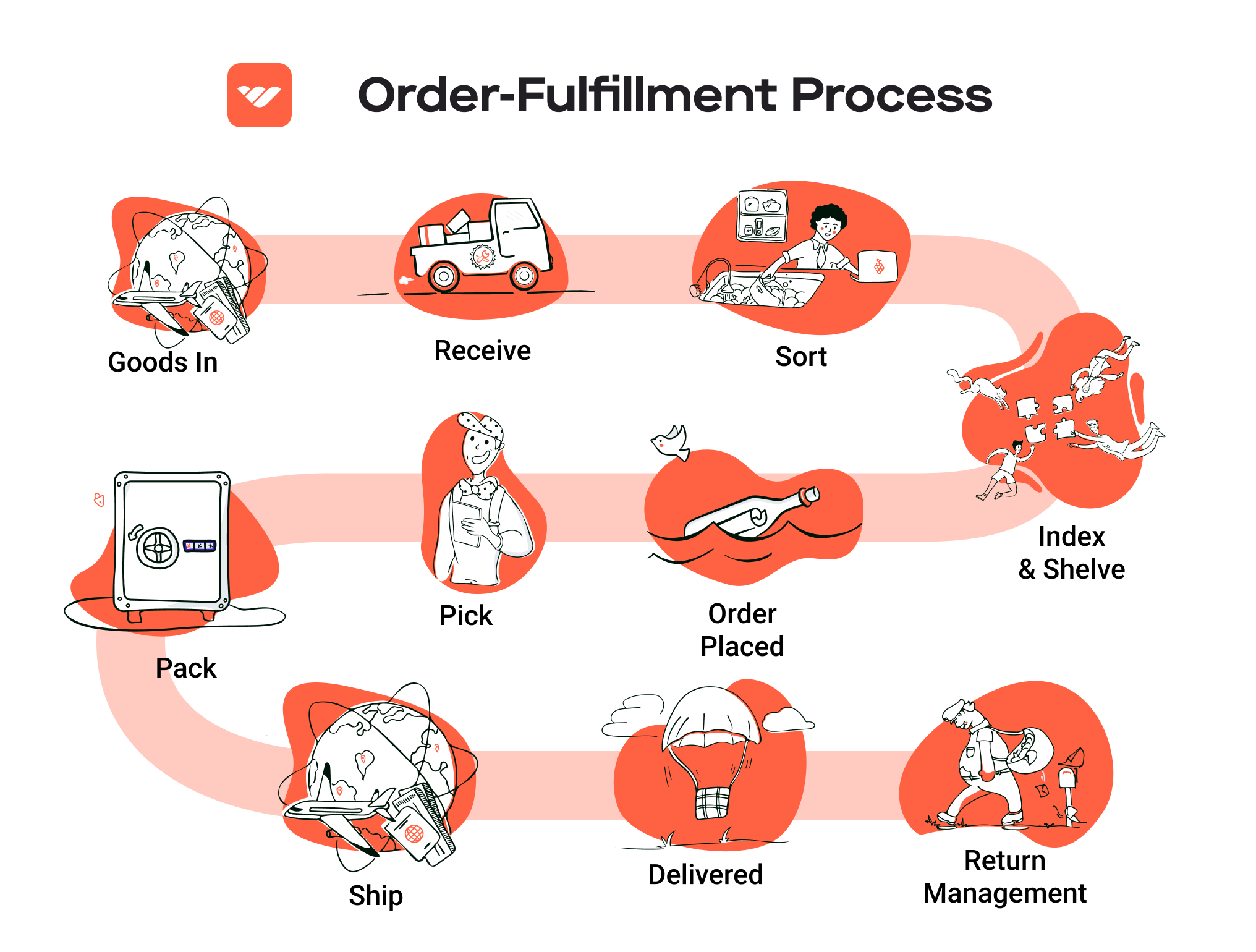
Importance: Timely shipping and delivery are key to customer satisfaction and retention. A reliable shipping process can set a business apart from competitors, especially in the e-commerce landscape where consumers expect fast and free shipping.
Key Term: Carrier Management. This involves selecting and managing relationships with shipping carriers to ensure optimal delivery times and costs. Effective carrier management can lead to better service levels and reduced shipping expenses, ultimately enhancing the overall fulfillment process.
By understanding and optimizing each of these five steps in the order fulfillment process, e-commerce businesses can enhance operational efficiency, improve customer satisfaction, and ultimately scale their logistics capabilities.
Comparing Fulfillment Models: In-House vs. 3PL vs. Dropshipping
Fulfillment Model Comparison
| Model | Who Handles Inventory | Best For (Business Stage) | Key Advantage | Key Disadvantage |
|---|---|---|---|---|
| In-House Fulfillment | The business itself | Established businesses | Full control over operations | High overhead and operational costs |
| Third-Party Logistics (3PL) | External logistics provider | Growing businesses | Scalability and expertise | Less control over inventory |
| Dropshipping | Supplier or manufacturer | Startups and small businesses | Low initial investment and risk | Potentially longer shipping times |
In-House Fulfillment
In-house fulfillment involves managing your own inventory, warehousing, and shipping operations. This model is ideal for established businesses that have the capital to invest in infrastructure and the expertise to manage logistics. By handling fulfillment in-house, companies maintain full control over their inventory, ensuring quality standards and faster response times. This model allows for customization in packaging and shipping processes, which can enhance brand identity and customer experience. However, the key disadvantage is the high overhead costs associated with maintaining a warehouse, hiring staff, and managing logistics. As businesses scale, the complexity of in-house operations can also increase, requiring sophisticated inventory management systems and additional labor, which may strain resources.
Third-Party Logistics (3PL)
Third-party logistics (3PL) providers offer businesses the ability to outsource their logistics operations, including warehousing, inventory management, and shipping. This model is particularly beneficial for growing businesses that need to scale quickly without the heavy investment in infrastructure. Partnering with a 3PL allows businesses to leverage the expertise and technology of logistics providers, often resulting in improved shipping efficiency and reduced costs. 3PLs typically have established networks and systems that can facilitate faster fulfillment and delivery times, which enhances customer satisfaction. However, the trade-off is a decrease in control over inventory and fulfillment processes. Businesses may face challenges in maintaining brand consistency in packaging and customer communication, as they rely on external partners to represent their brand.
Dropshipping
Dropshipping is a fulfillment model where businesses sell products without holding any inventory. Instead, when a customer places an order, the retailer purchases the item from a third-party supplier who ships it directly to the customer. This model is particularly suitable for startups and small businesses that want to minimize risk and reduce upfront investment. The key advantage of dropshipping is that it allows entrepreneurs to offer a wide range of products without the financial burden of inventory management or warehousing. This flexibility can lead to quicker market entry and the ability to test new products without significant financial commitment. However, dropshipping can come with its challenges, such as potentially longer shipping times and less control over product quality. Additionally, reliance on suppliers can lead to issues with stock availability and fulfillment accuracy, which can impact customer satisfaction.
In conclusion, choosing the right fulfillment model is crucial for scaling your e-commerce operations. Each model has its unique advantages and disadvantages, and the decision should align with your business goals, stage of growth, and operational capabilities. For established businesses seeking control and customization, in-house fulfillment may be the best choice. Conversely, growing companies can benefit from the scalability and expertise of 3PL providers. Meanwhile, startups looking to minimize risk and investment may find dropshipping to be the most viable option. Understanding these differences will help you make informed decisions that support your overall business strategy.
A Deep Dive into Amazon FBA: Pros, Cons, and Who It’s For
What is Fulfillment by Amazon (FBA)?
Fulfillment by Amazon (FBA) is a service provided by Amazon that allows sellers to store their products in Amazon’s fulfillment centers. When a customer orders a product, Amazon takes care of storage, packaging, shipping, and customer service on behalf of the seller. This streamlined logistics solution enables e-commerce businesses to leverage Amazon’s extensive distribution network and customer service capabilities, allowing sellers to focus on their core business activities such as product sourcing and marketing.
To utilize FBA, sellers first need to create an Amazon Seller account and choose the products they want to fulfill through the service. Once the products are listed, sellers ship their inventory to Amazon’s warehouses. Amazon then handles all aspects of fulfillment, including picking, packing, and shipping the products to customers. Additionally, FBA products automatically qualify for Amazon Prime, which enhances their visibility and appeal to millions of Prime members.
How Does FBA Work?
-
Setting Up: Sellers create an Amazon Seller account and select FBA as their fulfillment method. They can then list their products and prepare them for shipment to Amazon’s fulfillment centers.
-
Shipping Inventory: Sellers send their products to designated Amazon fulfillment centers. Amazon provides guidelines on how to package and label items to ensure efficient processing.
-
Storage and Fulfillment: Once received, Amazon stores the inventory in its warehouses. When an order is placed, Amazon’s system automatically picks the product, packs it, and ships it to the customer.
-
Customer Service: Amazon handles all customer inquiries, returns, and refunds related to FBA orders, providing a seamless experience for customers and sellers alike.
-
Payment: Sellers receive payments for sales, minus the applicable FBA fees, which are deducted from the sale price.
Pros of Using FBA
-
Prime Eligibility: One of the most significant advantages of using FBA is that products are eligible for Amazon Prime. This means faster shipping options, which can significantly increase sales, as Prime members tend to prefer products that can be delivered quickly.
-
Increased Customer Trust: Products fulfilled by Amazon come with the backing of Amazon’s customer service and return policies. This instills confidence in buyers, leading to higher conversion rates.
-
Multi-Channel Fulfillment: FBA allows sellers to fulfill orders from other sales channels (like their own website) using Amazon’s logistics. This helps sellers maintain a consistent inventory and shipping process across multiple platforms.
-
Scalability: As businesses grow, FBA can easily scale with them. Sellers can increase their inventory without the need for additional warehousing or logistics management, which is particularly useful during peak seasons.
-
Time Savings: By outsourcing fulfillment to Amazon, sellers can save significant time and resources that would otherwise be spent on packing, shipping, and handling customer service inquiries.
Cons of Using FBA
-
High Fees: FBA comes with various fees, including storage fees (charged monthly) and fulfillment fees (charged per unit). These costs can add up, especially for sellers with low-margin products or those with large inventories.
-
Strict Inventory Rules: Amazon has stringent guidelines on inventory management. Sellers must comply with these rules regarding product preparation, labeling, and packaging, which can be time-consuming and complex.
-
Commingling Risks: With FBA, products from different sellers may be stored together in the same warehouse. This can pose a risk if a product is returned or damaged, as it can be difficult to trace back to the original seller. Additionally, there’s a risk of counterfeit products being mixed in with genuine inventory.
-
Loss of Control: When using FBA, sellers relinquish some control over the fulfillment process. This includes shipping times, packaging aesthetics, and customer interactions, which may not align with a seller’s branding strategy.
-
Inventory Limitations: Amazon imposes limits on the amount of inventory sellers can store in its fulfillment centers. This can be a disadvantage for sellers looking to scale quickly or those with seasonal products that require larger stock levels.
Who is FBA Best For?
Fulfillment by Amazon is best suited for businesses that are looking to scale their operations and want to leverage Amazon’s extensive logistics and customer service capabilities. Here are some specific types of sellers who may find FBA particularly beneficial:
-
Small to Medium-Sized Businesses: Companies that do not have the resources to manage their own fulfillment operations can significantly benefit from FBA. It allows them to compete with larger brands without needing to invest heavily in warehousing and logistics.
-
E-commerce Entrepreneurs: New sellers entering the e-commerce space can use FBA to simplify the logistics of selling online and focus on marketing and product development.
-
Brands with High Sales Volume: Sellers with products that have a high turnover rate can capitalize on FBA’s efficiencies, particularly during peak shopping seasons.
-
Businesses Looking for Prime Visibility: Sellers who want to increase their product visibility and sales through Amazon Prime should consider FBA, as it enhances the attractiveness of their listings.
In conclusion, Fulfillment by Amazon offers a powerful solution for e-commerce businesses looking to streamline their operations and enhance customer experience. However, sellers must carefully weigh the benefits against the potential downsides, particularly regarding fees and inventory management, to determine if FBA aligns with their business goals.
Core Services Offered by Fulfillment Centers
Inventory Management & Warehousing
Inventory management and warehousing form the backbone of fulfillment centers, acting as a crucial service for e-commerce businesses. This service involves the systematic control of stock levels, storage, and organization within the warehouse. Fulfillment centers utilize advanced inventory management software to track products in real-time, ensuring that e-commerce businesses maintain optimal stock levels without overstocking or stockouts.
The benefits of effective inventory management are manifold. First, it provides accurate visibility into stock levels, allowing businesses to make informed purchasing decisions. This not only minimizes holding costs but also enhances cash flow by reducing the capital tied up in unsold goods. Furthermore, optimized warehousing practices—such as strategic product placement and automation—lead to improved order accuracy and faster fulfillment times. Ultimately, this translates into better customer satisfaction and repeat business, both of which are critical for scaling an e-commerce operation.
Pick and Pack Services
Pick and pack services are essential for ensuring that the right products reach customers in a timely manner. This process involves selecting (or “picking”) items from inventory based on customer orders and then packaging (or “packing”) them for shipment. Fulfillment centers employ efficient systems and trained staff to streamline this process, reducing the time it takes to fulfill an order.
The benefits of pick and pack services are significant. For e-commerce businesses, speed and accuracy in order fulfillment are paramount. By outsourcing these services to a fulfillment center, businesses can leverage the center’s expertise and technology to ensure that orders are processed swiftly and correctly. This not only enhances operational efficiency but also improves customer experience, as faster shipping times can lead to higher customer satisfaction and loyalty. Moreover, businesses can scale their operations without the need for investing in additional labor or infrastructure, allowing them to focus on growth and strategic initiatives.
Kitting and Assembly
Kitting and assembly services involve the grouping of individual items into ready-to-ship sets or the assembly of products before they are sent to customers. This service is particularly valuable for businesses that sell complex products or those that require multiple components to be packaged together. For example, a toy manufacturer may offer a playset that includes various toys and accessories, which need to be assembled into a single kit before shipping.
The primary benefit of kitting and assembly is the simplification of the order fulfillment process. By pre-assembling products, businesses can reduce the time and labor required during the shipping phase, which can lead to faster delivery times. Additionally, this service allows e-commerce businesses to offer unique bundled products that can attract customers and differentiate them from competitors. Kitting can also help in managing inventory more effectively, as it allows for better forecasting and reduced handling of individual items. Ultimately, this service enhances operational efficiency and can lead to increased sales through bundled offers.
Returns Management (Reverse Logistics)
Returns management, or reverse logistics, is an often-overlooked but critical service provided by fulfillment centers. This process involves handling returned products, assessing their condition, and determining the next steps—whether that’s restocking, refurbishing, or recycling items. Given that returns can account for a significant percentage of e-commerce sales, effective returns management is vital for maintaining customer satisfaction and loyalty.
The benefits of a robust returns management system are substantial. First, it enhances the customer experience by making the return process seamless and hassle-free, which can encourage repeat purchases. A well-managed returns process can also provide valuable insights into product quality and customer preferences, allowing businesses to make data-driven decisions regarding their product offerings. Furthermore, efficient reverse logistics can minimize losses associated with returns by ensuring that items are quickly processed and reintegrated into inventory when possible. This not only helps recover potential lost revenue but also contributes to sustainability efforts by reducing waste.
In summary, the core services offered by fulfillment centers—inventory management and warehousing, pick and pack services, kitting and assembly, and returns management—are crucial for e-commerce businesses looking to scale. By leveraging these services, businesses can enhance operational efficiency, improve customer satisfaction, and ultimately drive growth in a competitive marketplace.
How to Choose a Fulfillment Partner: A 6-Point Checklist
Location & Warehouse Network
Importance: The geographical location of your fulfillment partner’s warehouses directly impacts shipping times and costs. A partner with strategically placed facilities can help you reach your customers more quickly, which is crucial for maintaining high customer satisfaction.
Questions to Ask:
– Where are your warehouses located, and how many do you have?
– Can you provide shipping time estimates to key regions where my customers are based?
– Do you have a network that allows for regional distribution to reduce shipping costs?
Technology & Integrations
Importance: A fulfillment partner’s technology can significantly affect your operational efficiency. The right systems facilitate order processing, inventory management, and tracking. Moreover, seamless integration with your existing e-commerce platforms can streamline operations and improve data accuracy.
Questions to Ask:
– What technology platforms do you use for inventory management and order processing?
– Can your systems integrate with my e-commerce platform (e.g., Shopify, WooCommerce, Amazon)?
– Do you offer real-time tracking for shipments, and how is that information communicated to me and my customers?
Specializations (e.g., cold storage, oversized items)
Importance: Different businesses have unique product needs. If you sell specialized items like perishables or oversized goods, it’s crucial that your fulfillment partner has the necessary capabilities to handle these products effectively.
Questions to Ask:
– Do you have specialized facilities for handling specific types of products (e.g., cold storage, fragile items)?
– What experience do you have with my product category?
– How do you ensure product safety and compliance with regulations for specialized goods?
Scalability & Capacity
Importance: As your business grows, your fulfillment needs will evolve. A good fulfillment partner should be able to scale operations according to your business growth, whether that means handling more orders during peak seasons or expanding into new markets.
Questions to Ask:
– How do you handle seasonal fluctuations in order volume?
– What is your current capacity, and how do you plan to expand in the future?
– Can you provide examples of how you have supported other clients through periods of rapid growth?
Pricing and Contracts
Importance: Understanding the pricing structure is essential for budgeting and financial planning. Transparent pricing helps avoid unexpected costs, while flexible contract terms can provide security and adaptability as your business needs change.
Questions to Ask:
– Can you provide a detailed breakdown of your pricing structure, including any hidden fees?
– What are the terms of your contracts? Are there options for short-term or long-term agreements?
– How do you handle pricing adjustments as my order volume increases or decreases?
Customer Support & Reviews
Importance: Reliable customer support is crucial for resolving issues quickly and maintaining smooth operations. Additionally, researching reviews from other businesses can provide insights into the partner’s reliability and service quality.
Questions to Ask:
– What customer support options do you offer (e.g., phone, email, chat), and what are your hours of availability?
– How do you handle customer complaints or issues that arise during the fulfillment process?
– Can you provide references or case studies from other clients, and what do they say about your service?
Conclusion
Choosing the right fulfillment partner is a critical decision that can significantly impact your e-commerce operations. By using this checklist, you can systematically evaluate potential partners based on essential criteria that align with your business goals. Remember, the right partner should not only meet your current needs but also support your growth and adapt to the changing landscape of e-commerce.
Understanding Fulfillment Pricing: A Breakdown of Common Fees
Initial Setup Fees
Initial setup fees are one-time charges incurred when you begin using a fulfillment service. These fees cover the costs associated with onboarding your products into the system. Typically, they include account setup, software configuration, and initial inventory management. The exact fee can vary widely depending on the fulfillment provider, the complexity of your inventory, and any additional services you may require, such as branding or custom packaging.
To calculate initial setup fees, providers often take into account the number of SKUs (Stock Keeping Units) you plan to store, the volume of inventory, and the specific integrations required (e.g., linking your e-commerce platform to their system). As a business owner, it’s crucial to clarify all aspects of this fee during negotiations to avoid unexpected costs.
Receiving Fees
Receiving fees are charged when your inventory arrives at the fulfillment center. This fee typically covers the labor and resources needed to unload, inspect, and store your products. Receiving fees can be calculated based on the number of pallets or boxes received, or by the total weight of the shipment.
For example, a fulfillment center might charge a flat rate per pallet or a variable rate based on weight. Understanding this fee is essential, especially if you plan to send large shipments, as it can significantly impact your overall logistics costs. To optimize this expense, consider sending shipments in bulk rather than frequent smaller deliveries.
Storage Fees (per pallet/bin)
Storage fees are ongoing charges for keeping your inventory in the fulfillment center. These fees are typically calculated based on the space your products occupy, often measured in pallets or bins. The storage rate can be charged monthly, quarterly, or annually, and it may vary depending on the time of year, with higher fees during peak seasons (like holidays).
It’s important to differentiate between standard storage fees and long-term storage fees. Standard storage fees apply to products stored for less than a certain period (usually six months), while long-term storage fees apply to items that remain unsold for an extended period. Businesses should regularly review their inventory turnover rates to avoid incurring excessive long-term storage fees.
Pick & Pack Fees (per item/order)
Pick and pack fees are charged for the labor involved in selecting items from storage and preparing them for shipment. This fee is often calculated per order or per item, depending on the fulfillment provider’s pricing structure.
For instance, some providers might charge a flat fee for the first item in an order and an additional fee for each subsequent item. Understanding this fee structure can help you strategize your product offerings. For example, if you have a lot of variations or options for a single product, it might be more cost-effective to bundle them into a single listing to reduce pick and pack fees.
Shipping Fees
Shipping fees are charges incurred for transporting your products to customers. These fees can be complex, as they depend on various factors including package weight, dimensions, destination, and the shipping method chosen (e.g., standard, expedited, or same-day delivery).
Fulfillment centers often have agreements with shipping carriers, which can result in discounted rates for businesses. It’s essential to discuss shipping options with your fulfillment provider to understand how their pricing structure works and what services are included. Additionally, consider offering multiple shipping options to your customers to enhance their experience and potentially reduce your overall shipping costs.
Tips for Getting an Accurate Quote
-
Be Transparent About Your Needs: Clearly communicate your inventory size, order volume, and any specific requirements you have (e.g., special packaging or labeling) to receive a more accurate quote.
-
Ask for a Detailed Breakdown: Request a detailed breakdown of all fees involved, including any potential hidden costs that may arise over time.
-
Negotiate Rates: Don’t hesitate to negotiate fees, especially if you anticipate high order volumes. Many fulfillment providers are willing to adjust their pricing to secure long-term clients.
-
Consider Seasonal Variations: Be aware that some fees might fluctuate based on the season. Inquire about how these changes could affect your costs throughout the year.
-
Review Contracts Carefully: Before signing any agreements, ensure you understand all terms and conditions related to pricing and fees. Look for clauses related to increases in fees and what circumstances might trigger them.
By understanding these common fulfillment pricing models, e-commerce business owners can make informed decisions that align with their operational goals and budget constraints.
Frequently Asked Questions (FAQs) about Fulfillment
1. What is the Amazon fulfillment application process?
The Amazon fulfillment application process typically involves completing an online application where you’ll provide basic personal information, answer some assessment questions, and select your preferred shifts. After submitting your application, successful candidates are invited for a 30-minute virtual job preview, which offers insights into the role and expectations.
2. How do I know if my application was successful?
After you submit your application, you can check the status through your Amazon.jobs account. If your application moves from “Active” to “Archived,” it usually means you were not selected for the position. However, you can always reach out to the hiring team for clarification or updates.
3. What qualifications do I need to apply for a fulfillment position?
To apply for a fulfillment position at Amazon, you must be at least 18 years old, have a high school diploma or equivalent, and be physically capable of lifting up to 49 pounds. Additionally, you may need to pass a pre-employment drug test.
4. What’s the difference between a warehouse and a fulfillment center?
A warehouse is primarily used for storage, while a fulfillment center is a specialized type of warehouse that focuses on processing and shipping orders directly to customers. Fulfillment centers are equipped to handle a higher volume of orders and often have advanced technology to streamline operations.
5. How much do fulfillment services cost?
Fulfillment service costs can vary widely depending on factors such as order volume, storage space requirements, and the specific services offered. Generally, costs can include storage fees (per cubic foot), picking and packing fees (per order), and shipping fees. It’s essential to evaluate multiple providers to find the best fit for your business needs.
6. What is a 3PL, and how does it relate to Amazon fulfillment?
A 3PL, or third-party logistics provider, is a company that offers logistics services to businesses, including warehousing, fulfillment, and shipping. Amazon’s Fulfillment by Amazon (FBA) can be seen as a 3PL service, as it allows third-party sellers to store their products in Amazon’s fulfillment centers, from which Amazon handles the picking, packing, and shipping.
7. Can I apply for a fulfillment position if I have a criminal record?
Amazon conducts background checks as part of the hiring process. Whether you can be hired with a criminal record depends on the nature of the offense and how long ago it occurred. It is advisable to be honest during the application process and to inquire directly with HR if you have concerns.
8. Are there opportunities for advancement in Amazon fulfillment centers?
Yes, Amazon offers various pathways for career advancement within its fulfillment centers. Employees can move up to supervisory and managerial roles or transition into corporate positions. Continuous training and development programs are often provided to help employees grow their skills.
9. What benefits can I expect when working at an Amazon fulfillment center?
Employees at Amazon fulfillment centers can expect a range of benefits, including competitive hourly wages (often starting at $18/hr), health insurance, paid time off, and opportunities for overtime. Some locations also offer signing bonuses and employee discounts.
10. How flexible are the working hours at Amazon fulfillment centers?
Amazon fulfillment centers typically offer various shift options, including overnight, early morning, and weekend shifts. While employees can express their shift preferences during the application process, flexibility may vary based on the specific location’s staffing needs. Full-time positions are more common, but some part-time opportunities may be available.
Conclusion: Is Outsourcing Fulfillment the Right Move for Your Business?
Evaluating the Benefits of Outsourcing Fulfillment
In today’s competitive e-commerce landscape, outsourcing your fulfillment can be a game-changing strategy for your business. By leveraging fulfillment services, you can save significant time and resources that would otherwise be spent on managing logistics and warehousing. This allows you to focus on core business activities such as marketing, product development, and customer engagement.
Another key benefit is scalability. As your business grows, so does the complexity of your fulfillment needs. A reliable fulfillment partner can seamlessly accommodate fluctuations in order volume, ensuring that you can scale operations without the headache of overhauling your internal processes. This flexibility is crucial, especially during peak seasons or unexpected surges in demand.
Moreover, fulfillment centers bring a wealth of expertise to the table. They are equipped with advanced technology and processes that streamline operations and improve order accuracy. This not only enhances customer satisfaction but can also lead to reduced shipping costs and faster delivery times—factors that are increasingly important to today’s consumers.
However, the success of outsourcing fulfillment hinges on selecting the right partner. Not all fulfillment services are created equal. It’s essential to evaluate potential partners based on their track record, technology capabilities, and customer service standards. A strategic partnership can propel your growth, while a poor choice can hinder your operations.
Call to Action
As you consider the potential of outsourcing fulfillment, take a moment to audit your current shipping process. Are you experiencing bottlenecks or inefficiencies? Identifying these pain points can help you determine whether a fulfillment partner could enhance your operational efficiency and support your business growth. Embrace the opportunity to transform your logistics strategy—your future success may depend on it.
Important Disclaimer
⚠️ Important Disclaimer
The information in this guide is for educational purposes. Fulfillment services, pricing, and platform features change frequently. Always conduct your own due diligence and consult with providers directly before making business decisions.

